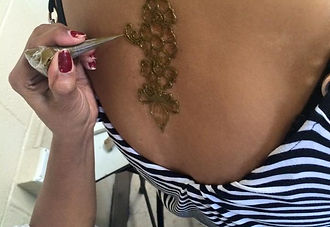
What's Henna
Creation of the instant, pleasure of a moment, isn't the resource to henna its search for beauty, aesthetic, emotion, ephemeral art. If it can sometimes incite the scandal, it provokes also fascination and wonder. Cultivating the mysterious, tickling the sensuality, the trace of henna captures the eyesight and wakes up curiosity.
Henna tattoo is an ancient Indian Body Art. It is used in creating intricate ethnic or contemporary designs and exotic patterns on various parts of the body, though traditionally applied to the hands and feet of women preparing for special ceremonies. henna is used as a blessing to remind us of the happiness life holds.
Once thought only for women, men and women enjoy the "temporary tattoo". The process of applying henna in this manner is called "mehandi" an ancient ritual and art form dating back 5000 years and is considered good luck in India, Middle East and North Africa. No Indian wedding is ever complete without the mehandi, whichever part of the country the bride may be form, her hands are adorned with the lovely red hue of the mehandi.
The appeal ? Painless temporary tattoos. Cutting edge. Cool. Painless. Fun. No needles,just a paste. What was in this month might be out the next, so with henna a lifetime commitment(like real tattoos) is not necessary as the designs fade within a 1-4 weeks.

Historical facts
For over 5000 years, the people of Africa, Middle East and India have practiced the beautiful and mysterious art of painting on the body with preparations using the henna-plant. This art form is also referred to as mehandi.
The henna-plant is thought to come from Egypt where it was called Egyptian Private. Later henna(mehandi) was brought to India as a state gift from the Egyptians.
Queen Mumtaz who ruled in the 1600's was the first Indian queen to be decorated with henna tattoo.Today,it is common to find artists practicing their henna crafts outside the Taj Mahal, Which was built to honor Queen Mumtaz. Traces of henna have been found on mummies from 1200 BC. It is also known that pharaohs hands and feet were first dipped in henna prior to mummification.
Traditionally, henna tattoo and the mehandi art form is an important part of wedding ceremonies. The hands and feet of the bride are decorated be professional henna artists, called hannayas in morocco. The intricate and beautiful designs cover her hands and feet in a lacy manner. It is common belief that henna brings good luck.
Henna tattooing is the hottest trend to come from the East. Its popularity exploded in 1998 in New York City, and is fast becoming the most sought after, fascinating beauty creations in North America. Many celebrities have been proud to show their henna tattoos in public, on the big screen, and in music videos.
Henna is a natural organic product which has been used for thousands of years in many parts of the world as a perfume but most significantly as a reddish colorant and conditioner for hair.

Scientific facts
Scientifically referred to as Lawsonia Inermis, henna in the west is most commonly used to dye hair. But with the new popularity of tattoos, henna tattoo and the art of mehandi is considered a safe ,painless and non-permanent alternative form of body ornamentation. Although henna is traditionally drawn only on the hands and feet, feel free to create your designs on arms, legs around the belly button, and even may be behind the neck.
Henna extracts show antibacterial, anti-fungal, and ultra violate light screening activity. Henna has exhibited anti-fertility activity in animals and may induce menstruation. The flowers possess a pleasant aroma and crude perfumes are produced in some major growing areas by preparing a suspension of communicated flowers in vegetable oil.
Henna and the art of mehandi is considered a safe, painless and non-permanent alternative form of body ornamentation.
Although henna is traditionally drawn only on hands and feet, feel free to create your designs on arms, legs, around the belly button, and even may be behind the neck.